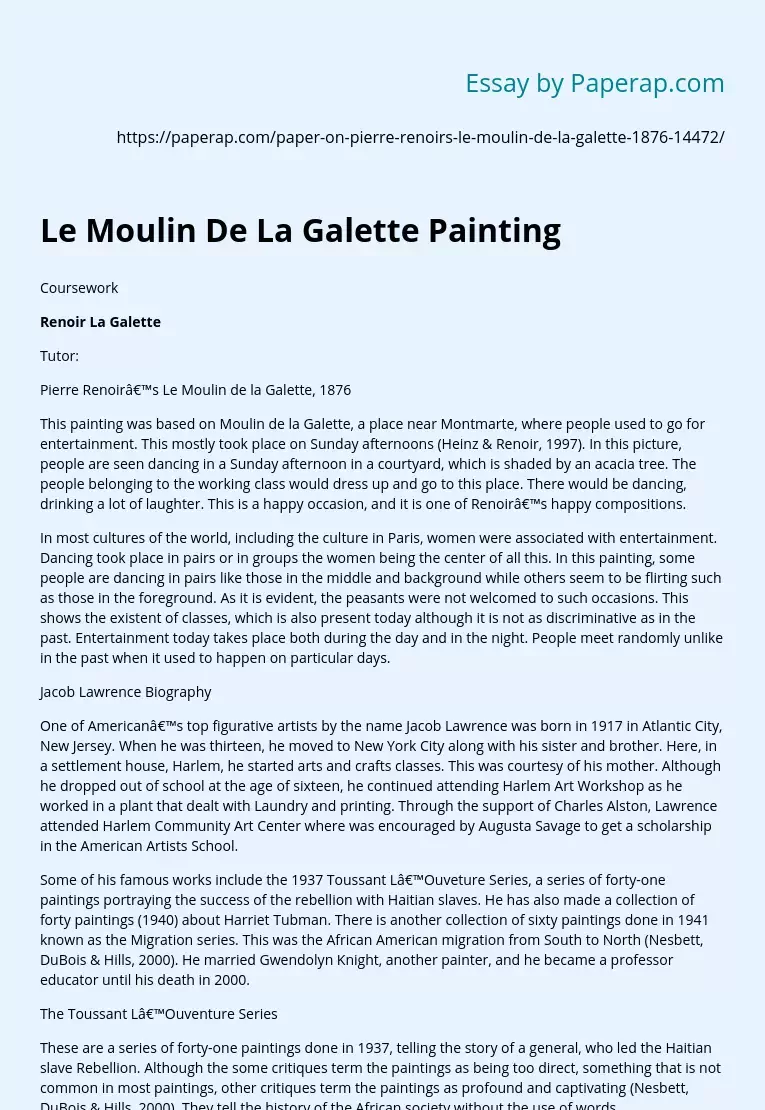This painting was based on Moulin, where people used to go for entertainment. This mostly took place on Sunday afternoons. In this picture, people are seen dancing in a Sunday afternoon in a courtyard, which is shaded by an acacia tree. The people belonging to the working class would dress up and go to this place. There would be dancing, drinking a lot of laughter. This is a happy occasion, and it is one of Renoir’s happy compositions.
In most cultures of the world, including the culture in Paris, women were associated with entertainment.
Dancing took place in pairs or in groups the women being the center of all this. In this painting, some people are dancing in pairs like those in the middle and background while others seem to be flirting such as those in the foreground. As it is evident, the peasants were not welcomed to such occasions. This shows the existent of classes, which is also present today although it is not as discriminative as in the past.
Entertainment today takes place both during the day and in the night. People meet randomly unlike in the past when it used to happen on particular days.
One of American’s top figurative artists by the name Jacob Lawrence was born in 1917 in Atlantic City, New Jersey. When he was thirteen, he moved to New York City along with his sister and brother. Here, in a settlement house, Harlem, he started arts and crafts classes. This was courtesy of his mother.
Although he dropped out of school at the age of sixteen, he continued attending Harlem Art Workshop as he worked in a plant that dealt with Laundry and printing. Through the support of Charles Alston, Lawrence attended Harlem Community Art Center where was encouraged by Augusta Savage to get a scholarship in the American Artists School.
Some of his famous works include the 1937 Toussant L’Ouveture Series, a series of forty-one paintings portraying the success of the rebellion with Haitian slaves. He has also made a collection of forty paintings (1940) about Harriet Tubman. There is another collection of sixty paintings done in 1941 known as the Migration series. This was the African American migration from South to North. He married Gwendolyn Knight, another painter, and he became a professor educator until his death in 2000.
These are a series of forty-one paintings done in 1937, telling the story of a general, who led the Haitian slave Rebellion. Although the some critiques term the paintings as being too direct, something that is not common in most paintings, other critiques term the paintings as profound and captivating. They tell the history of the African society without the use of words. After the paintings were made, Lawrence tried to transfer the paintings to silk so that he could give them a modern form. Nevertheless, the main theme of the paintings, which depicted the quest for freedom and the presence of black heroes, strengthened the African American community, as it was going through its own challenges at that time.
The sixty panel series of paintings done in 1941, tell the story of African Americans after the First World War. In these paintings, the theme of war and peace are the most evident. As well identified with the other paintings, the paintings look as though a child was playing with different types of colors. However, when one closely studies the paintings, the story starts becoming evident. The uses of diverse colors show the mood of the paintings. Like most of Lawrence’s paintings, they are self-explanatory. The struggle of the African American is evidently seen as they such for peace in the midst of the warring nations.
References
- Heinz, F., & Renoir, A. (1997). “Au Moulin de la Galette”: Strange encounters with Pierre Auguste Renoir’s finest and best loved work of art : the lost “Sketch from Nature,” a study of Renoir’s art. Munich: Universitas.
- Nesbett, P. T., DuBois, M., & Hills, P. (2000). Over the line: The art and life of Jacob Lawrence. Seattle, WA: University of Washington Press in association with Jacob Lawrence Catalogue Raisonne? Project.
Le Moulin De La Galette Painting. (2019, Dec 05). Retrieved from https://paperap.com/paper-on-pierre-renoirs-le-moulin-de-la-galette-1876-14472/

